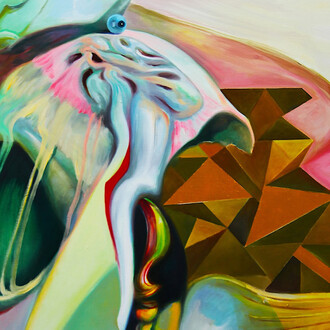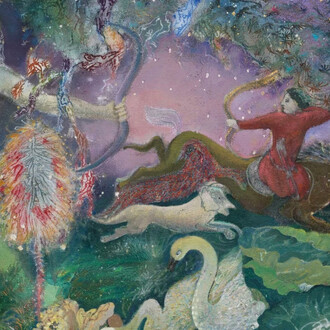Almine Rech New York, Upper East Side is pleased to present Sky got dark, Amanda Wall's fourth solo exhibition with the gallery, on view from June 26 to August 2, 2024.
Empty, my hand comes back tinted with iridescent pale blue nectar. The sugary residue on my fingers merges with the bitter smell of the cigarettes I smoked. Their earthy and humid scent still sits on my lips, unapologetic just as the anxiety I taste when puffing three at once. I smoke my void away. Sometimes, I gently try to suffocate it. Parted lips, I bite a silky, gag-like ribbon. I inhale and exhale through my nose. As the faded purple fabric gets darker, soaked in saliva, I feel somehow comforted. I surpass myself, I abdicate myself, relieved for a moment from the unruliness of existence.
Transcending the visual, the work of Amanda Wall comes with an inebriating sensorial quality. As she swallows us in her surreal soulscapes imbued with voluptuous yet muted glossy tones, a creamy and tangy smell almost seems to impregnate our nostrils. Time collapses in a gloomy penumbra. The sound gets absorbed by an impending collision. Suddenly, only the rhythm of our own breathing fills the room.
Sky got dark sees the recurring motifs of Wall’s visual vocabulary constitute new emotional scenarios. Plump blue cherries, distorted objects, tender lips, long-legged figures and grasping hands vacillates between reality and psychological absurdity. Their confines lead the gaze towards fleeting and enigmatic cityscape horizons where, ominous of a catastrophe, the troubled sky seems like the smooth stretched skin of a fruit. An evolution of the shadowy, saturated color fields that define the artist's production, these dawning urban panoramas emerging far away behind the subjects, seem to further enhance their isolated state. Bodies wrestling with their own borders, mirror the intimate and fragmented experience of being alive. The existential plurality of the self is confronted with the stillness of bodily matter. It’s their inherent porosity that Wall’s convulsive figures try to grapple with. Driven by an instinctive ecstasy, they crawl, leaning towards uncanny peripheries. The body turns into landscape.
The series is diluted in various scales that encompass the artist's traditional large canvases, while also engaging with smaller, more intimate formats that still encapsulate the seductive compulsion of Amanda Wall’s visual language. Exploring the boundaries of classical portraiture and experimenting with the parameters of technique, Wall’s vibrant gestural confidence preserves the instinctiveness for which her work is known, blurring the boundaries of intimacy between voyeur and subject.
Prey to gravity, I lazily bring the knees toward my chest, while flesh and bones press against the rigid floor. There, nestled in my own body weight, crawling like a sea anemone, the horizon collapses and perspective fragments into a watery, haze. Suddenly, my gaze is invaded by a tender, distorted presence, wrapped in lurid magenta lycra stockings. I can almost feel it, blood-warm, rubbing against my cheek. Whose face am I caressing with the tip of my toes? There is only me in the room. It is my whole body wrestling with myself.
Amanda Wall’s uncanny and contorted perspective implicates us, the viewers, to the extent that we're not merely observers lying on the floor beside that body twisting before us; rather, we become that very body. Legs apart, hips bending toward the right, fingers grasping the ground, it is our body crawling, twisting, stretching. We are looking at ourselves, at our placid void, at our delightful anxiety, at the sweet impending doom that relentlessly sticks to the bottom of our viscera. The end of the world tastes like sugar and dust.
(Text by Maddalena Iodice. Author and curator)
















